
Back to Loco of the Month homepage
Back to Sidestreet Bannerworks
.
November 2004
Mike Gaskin’s 4-8-2
by Marc Horovitz

The Romney, Hythe & Dymchurch Light Railway is probably the best-known 15"-gauge line in the world. It runs between Hythe and Dungeness, a distance of 15 miles or so, near the southeast coast of England. It was the brainchild of two famous auto racers of their day -- Capt. J.E.P. Howey and Count Zborowski of Poland. Sadly, the Count was killed in an auto race before the railway was even begun, and Capt. Howey proceeded alone. He signed on Henry Greenly as Chief Engineer, and the first section of the line opened in 1927.
The RH&D is a miniature railway, using one-third-scale models of full size engines to haul its trains. It is still in operation today and owns several locomotives, most designed by Greenly and built by Davey Paxman. Two, Hercules and Samson (both built in 1927), are of the 4-8-2, or "Mountain", wheel arrangement. All of the other large engines are Pacifics (4-6-2).
Much has been written about the railway, and it has its own web site. Check it out if you'd like to learn more.
The model
Mike Gaskin is a competent, though not well known, locomotive builder in England. Two of his other engines, Ceylon and Matheran, have been featured in these pages. The engine examined here is Nº 23 from Gaskin's Caterham Works. While not a scale model of either of the Romney Mountains, it is definitely patterned after them, sharing their proportions. This gives it a most unusual scale/gauge combination. It is a 1/12 scale model of a 1/3 scale model, and it runs on 32mm (0-gauge) track.
Nº 23 is a sophisticated locomotive. It has a locomotive-type boiler with seven flues and a superheater tube. It is fired by a two-wick alcohol burner that includes a stainless-steel arch. There is an axle pump on the second driven axle, with the usual bypass system. The tender holds both water and fuel, and there is a hand pump in it as well. The pump handle resides in special brackets atop the tender. The fuel-control system is fairly primitive. A plastic tube emerges from the bottom of the fuel tank and runs back to a sump. A device that clamps down on the tube is built into the bottom of the tender to restrict the flow of alcohol to the sump. From there the line runs forward to the burner. Strange system, but it works OK.
Mr. Gaskin made liberal use of epoxy, both to seal places where pipes emerged from tanks (but not on the boiler) and to attach cosmetic bits. Some of these joints, particularly the smaller cosmetic ones, like the handrail stanchions, have failed. Repairs have been scheduled.
The cylinders are standard D-valve cylinders, controlled by slip-return-crank reversing. The springing, axle boxes, etc. on the trailing truck are attached to the frame and are dummies. The truck itself is pivoted and swings between the frames.
The run
Bright, sunny day, temperature in the 40s, and a howling wind -- a perfect steaming day for alcohol-fired engines. After oiling the engine all around, I filled the tender with water, attached the pump handle, and gave it a couple trial strokes. The engine hadn't ben run in a while and I could feel that one or more of the check valves was stuck. Sometimes, a little pressure will free them. This time, however, the pump just fell to pieces, which will necessitate a complete tear-down of the tender. On to more direct methods. I removed a safety valve and filled the boiler that way. The water glass is one of the thinnest I have seen, and therefore not to be relied on. I could barely see it, anyway.
Once the boiler was what I judged to be full, I filled the lubricator with steam oil and the large fuel reservoir in the tender with alcohol. After placing the engine on the track and the fan in the smokestack, I lit the fire through the firebox door. This is the only way to light it, as the burner is otherwise inaccessible.
After a few minutes, pressure started to come up. At about 15 pounds, I took off the fan and turned on the blower. I was treated to an impressive geyser. I'd overfilled the boiler and the expanding water shot out the blower pipe in a most satisfying manner. When this had died down (and all pressure lost, as well as the fire), I replaced the fan and relit the fire. When pressure had regained its former place, I cautiously opened the blower again. This time all was well, so I removed the fan. Pressure continued to climb until one of the safeties popped at 50 psi.
I opened the throttle, closed the blower (but not all the way), and gave the engine a push. It took several revolutions of the drivers for the condensate to clear and the engine to show signs of life. However, once it did, things were good. The locomotive has a soft, but deep-throated chuff, due to the large smokebox. With the cab-roof extension off, the throttle was easily accessible. The engine proved to be responsive to the touch and it ran elegantly and smoothly. It was great watching those eight drivers revolve and all those red rods flailing around.
Reversing the engine is just a matter of stopping it and pushing it backwards a few inches to reset the return cranks. It ran just as smoothly in reverse. After a while, I closed the bypass valve and put the axle pump to work. Eventually, the fuel ran out and I shut the engine down. The run had lasted around 40 minutes, but I could have kept it in steam all day.
The cool weather made for great steam effects. I've long felt that the ideal steaming weather is when the temperature is in the mid 40s, with bright sunshine to keep the drivers warm. Today's run was proof of that. The engine ran superbly and looked great in the autumn sunshine, with steam pouring from the stack and a wisp showing at the safeties. It was a grand day out.
.
|
|
|
| Builder | Mike Gaskin (UK) |
| Date built | Circa 1995 |
| Gauge | 32mm |
| Scale | 1" = 1'-0" |
| Boiler | Locomotive type, with 7 flues and 1 superheater tube |
| Fittings | Safety valves (2), water glass, pressure gauge, blower, bypass valve, throttle, check valve |
| Fuel | Alcohol |
| Blow-off pressure | 50 psi |
| Cylinders | Two, double-acting D-valve |
| Reversing gear | Slip return crank |
| Lubricator | Displacement |
| Weight | 14 lb. 8 oz. |
| Dimensions | Length overall, 27-1/2"; width, 3-12", height, 4-5/8" |


The proportions of the engine are very close to its 15"-gauge prototype. On the RH&D, the driver sits in the forward part of the tender. The long boiler and tender make this an elegant and impressive locomotive.
.

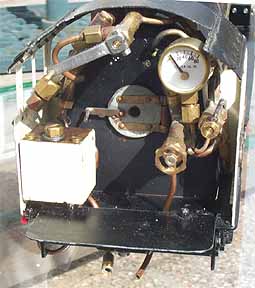
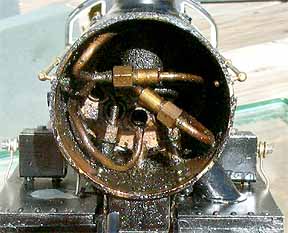
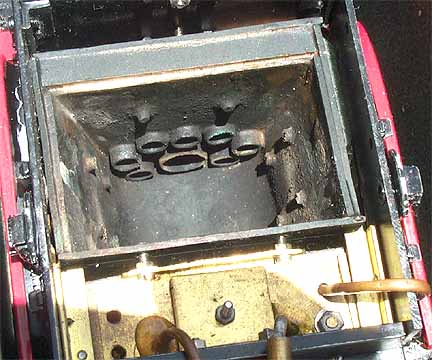
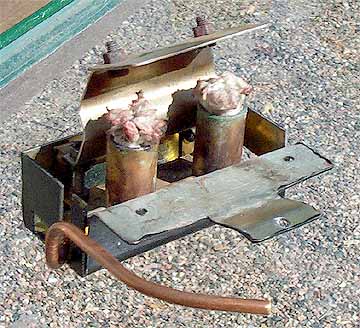
Looking into the firebox from below, you can see the flues. The large one in the middle is for the superheater. This is a dry-leg firebox. The only wet leg is the forward one, next to the boiler barrel.
.
This unusual burner is fully enclosed in the firebox. The stainless-steel arch is above the two wicks. You wouldn't think that just two wicks would fire a locomotive of this size, but this burner has no trouble.
.
.
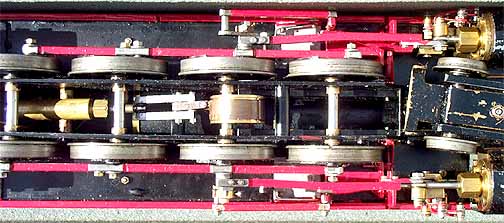
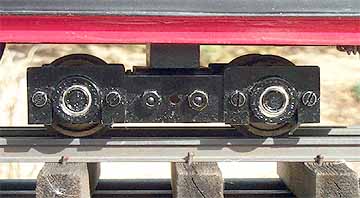
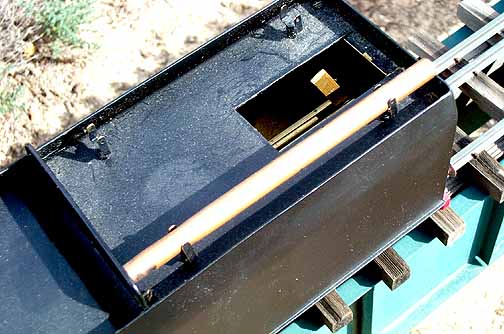
Above: The tender rides on these interesting ball-bearing trucks. Right: A hand pump resides in the back of the tender. This one disgraced itself today. The tube on top is the pump handle in its cradle.
.
.

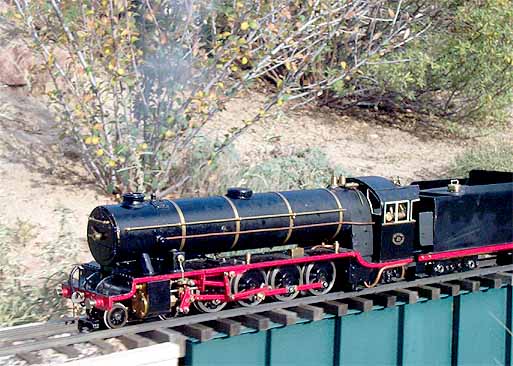
The engine at speed during the run.
Back to Loco of the Month home page
Back to Sidestreet Bannerworks home page
This page and its contents
Copyright Sidestreet Bannerworks, 2004
.